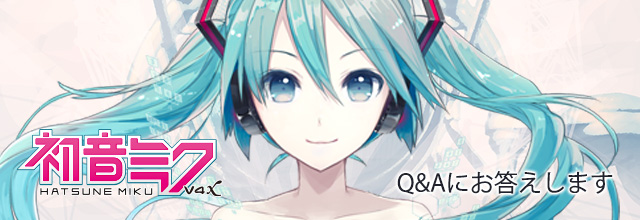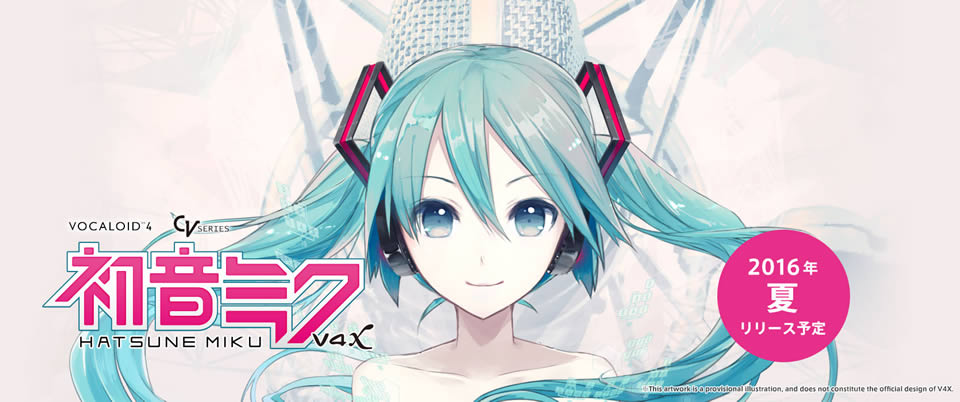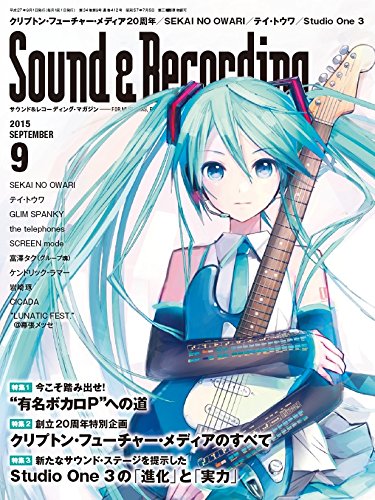
Roughly a week ago, Crypton Future Media’s Sasaki Wataru (head of Hatsune Miku’s Vocaloid software development) published a Q&A regarding Hatsune Miku’s V4X software development, and helps shed light on many questions from fans. Descent87 helped out with translating the Q&A, which we’re extremely grateful for. Read the full Q&A below!
What is Hatsune Miku V4Xβ?
[Hatsune Miku V4Xβ] is the beta version of the [Hatsune Miku V4X] software which was created based on the original Hatsune Miku voice bank. Along with improvements to pronunciation and sound quality, it features the newly developed [E.V.E.C. Feature] which allows for adjustment of the VB’s voice strength settings. Along with being cross-compatible with every voicebank in the [Hatsune Miku V3] library, it also supports “growling”.
About Hatsune Miku V4Xβ’s Free Distribution
Users which own both [Hatsune Miku V3] and [Megurine Luka V4X] will be able to download [Hatsune Miku V4Xβ] and use it for the time period ending on August 31st, 2016. Details of a method for other people to participate in the beta testing will be released at a later date.
[Hatsune Miku V4Xβ] contains only a portion of the [Hatsune Miku V4X] voice library. It is anticipated that the commercial product will contain multiple libraries.
(Link for method and details of obtaining [Hatsune Miku V4Xβ])
【Hatsune Miku V4Xβ Q&A】
Will the sound of Hatsune Miku V4Xβ be different from the original Hatsune Miku?
↓
While the fundamental aspects of the voice will not change, the tone and the pronunciation speed have been made noticeably “crisper”. We believe that when it comes to uptempo songs, rap, and other quickly spoken lyrics featuring complex pronunciation, that this version will have greater vocal clarity when compared to all past versions of Hatsune Miku. On the other hand, it could be said that when it comes to ballads and other slow songs, it will often be difficult to detect a significant difference from the V3 voicebank, but through a multiple song comparison we feel that you will be able to notice a difference in pronunciation and sound quality. We are also working to make the voice more resilient to past problems where it would become buried in the instrumental accompaniment. We are actively working to reduce the problem where the VB’s pronunciation was understandable in the editor but the addition of the orchestral accompaniment results in a degradation of consonant clarity.
Will there be any improvements for Hatsune Miku’s singing range when compared to past versions?
↓
It is difficult to move away from the recommended (G2~F4) singing range, but we have made adjustments to the lower-end of the singing range which will hopefully allow you to use the G2~C3 range somewhat more effectively in lower songs. We are working to improve the quality of vowel pronunciation in the extremely high parts of the vocal range. It should also be noted that the voiced consonants “ba, bi, bu, be, bo” and “da, ji, zu, de, do”, etc. have also had improvements to their sound quality.
What kind of people do you recommend Hatsune Miku V4Xβ to?
↓
We recommend it for the following kinds of people:
#1 Beginners: Even without major tuning adjustments, it is able to sing covers with high pronunciation stability. If you intend to shoot for one fixed singing style, making broad, general adjustments to the dynamic parameters is fairly easy.
#2 People who can make “intense” songs: We have improved the resilience of the voice such that consonants can be heard easily and “drowning out” of the voice can be avoided even when loud noises like guitars, synthesizers, and snare drums are employed.
#3 People who want to make detailed adjustments to their songs/singing: We’ve made it so that users will be able to better predict the results of their parameter changes.
Since Hatsune Miku V4Xβ comes pre-loaded with the E.V.E.C feature, will it be difficult for beginners to use?
↓
The software is set up such that whether you make use of E.V.E.C. or not, it will try to sing to the best of its abilities. The “VoiceColor” feature and the standard vocal DB (database) have been adjusted such that they don’t have major differences in their voice volume. VoiceColor only especially allows for adjustments to the “Springiness” or “resilience” of the voice and overall the software is set up to allow users to get more and more familiar with it over time. Especially in the case of “Soft”, the “springiness” of vowels grows weaker, and if interposed effectively with the melody, we recommend it for creating a softer intonation. Combining vocal tuning and VoiceColor is also effective, and as such when using “Soft”, having the vocal dynamics grow smaller while when “Power” is applied having the vocal “springiness” grows much larger is something we tried to emphasize. Reversing these settings also leads to some interesting results and we definitely recommend trying to play with them and compare them to the normal voice.
What are some of the ways you recommend using the new features included in Hatsune Miku V4Xβ?
↓
Hatsune Miku V4Xβ is set up such that it is the primary VB for the cross-synthesis with the secondary (slave) being Hatsune Miku Dark, Sweet, and other softer voices from the Append library. If you set the value of the cross synthesis somewhere between 30 to 64, the voices will blend. When using the VoiceColor feature of E.V.E.C (Soft/Power settings) you can easily make adjustments to the “springiness” of the voice. You can also try combining the “growling” ability with VoiceColor “Power” to get some “projectile weapon” like explosive effects.
**As for the Hatsune Miku V4Xβ cross synthesizer, the Dark, Sweet, and Soft VBs are considered to be a much better match than the SOLID VB.
Since Hatsune Miku V4Xβ can be considered the base version of the software, what modifications and improvements do you have planned for the future?
↓
We have plans for the following features:
・Tuning improvements based on beta tester feedback
・A closer look at adjustments and improvements to the VoiceColor feature
・The release of the VoiceRelease add-on
・Looking into development of other custom phoneme editors like VoiceColor.
・A way to do minor tuning of phonemes with a special focus on phonemes from the “Ra”, “Ma”, and “Ya” columns of the hiragana syllabary.
・Allowing for tuning of the sound between multisamples. (?)
・Looking at broadening the vocal range that we can recommend.
・The implementation of phonemes that connect between breath and consonant phoneme elements.
・Possibly including WAV files with breath and consonants as stand alone elements.
・Providing reference VSQX data for special types of recording.
What are the required specifications and required operating environment for the installation of the Hatsune Miku V4Xβ software?
↓
In addition to having a Windows or Mac OS, approximately 2GB will be required. With regards to other specifications for the operating environment, customers who are able to use Megurine Luka VX4 (Amir: link the above link) should not have any problems.
If I have any problems or concerns when making Hatsune Miku V4Xβ sing, how should I file a bug report?
↓
When filing a bug/problem report with regards to Hatsune Miku V4Xβ, please include the VSQX data reflecting the issue in an email to [email protected]. We will then conduct an assessment of the issue and use any findings to further improve the Hatsune Miku V4X software. Please feel free to contact us with regards to these issues at any time.
When making use of the E.V.E.C features VoiceColor settings, I somehow feel that Miku’s pronunciation actually got worse. Why is that?
↓
VoiceColor, is doing what can essentially be called “Vowel Partitioning” (In the Vocaloid Editor, we have taken a single phoneme and broken it into a separate pronunciation and vowel notations) When it comes to very detailed notation patterns, it is possible that phonemes crammed to close together will result in the pronunciation being overpowered by the vowel sound and we recommend that you use caution in those instances. For these reasons we feel that VoiceColor is at its best when employed at the end of long tones and phrases.
【Other questions】
You have currently decided to distribute Hatsune Miku V4Xβ to users of Hatsune Miku V3 and Megurine Luka V4X. What is the reason for that?
↓
First of all, we were hoping to get feedback from frequent and experienced users of the Hatsune Miku VB. If users did not already have the Vocaloid 4 engine and the newest version of Piapro Studio, then we would have to provide this software free of charge, and we instead decided to ask users of Megurine Luka V4X to provide feedback for us.
Can you use Hatsune Miku V4Xβ outside of PiaproStudio?
↓
Our company recommends it to be used with PiaproStudio, but excluding the E.V.E.C. features, all other parts can be used with the VOCALOID4 Editor. Making use of the E.V.E.C features requires you to be able to use special notation (like a#2 for example, after vowels or vowel partitions, adding #2 for SOFT and #6 for POWER, ect) (Unsupported in VOCALOID4 Editor).
Do you have any plans for allowing general beta testing outside of the current user/customer base?
↓
In a joint project with DTM Magazine, we have opened beta testing recruitment starting a few days ago. We will begin distribution in early October. Please wait a bit longer for more details.
Where do you see Kagamine Rin/Len V4X going from here?
↓
While making efforts to improve the pronunciation and prevent the vocals from being drowned in the music, we will be making use of the wave forms/voice from ACT 1 and improving on it to create the loudest/strongest voice possible. We are also planning to eventually include some refinements for the Rin/Len Append DB as well.
*We plan on integrating/unifying each ACT 1 VB with it’s respective Power Append.
What is the relation between the upcoming Kagamine Rin/Len V4X and Hatsune Miku V4Xβ? When taking the expected order into account I expect the development Rin/Len V4X to come first, but…
↓
With regards to the introduction of this new system for creating Vocaloid software, around the time when we began to think about ways to test and implement improvements to the pronunciation and consonants, we decided that using the original Hatsune Miku VB we have worked so carefully on would be the best place to start. The fundamental elements of the original Hatsune Miku VB were within a range that was useful in creating this new type of software and provided us with a significant amount of data to analyze and make use of. Having been able to effectively demonstrate improvements of the original Hatsune Miku voice, we are applying the same principals to Kagamine Rin/Len V4X with the aim of improving the pronunciation and the vocal carry of the VB, and we also plan to make use of opinions gathered from Hatsune Miku V4Xβ testers in its development going forward.
Is there anything else you would like to know? (aka not included in this Q&A)
↓
For all questions that do not involve product support, please contact us at “[email protected]” Since this is the email of the development team, please forgive any delay in our response.
V4X Project and Production Director: Sasaki Wataru a.k.a. wat



